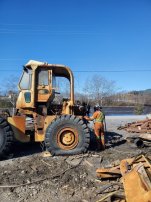dgfoster
Diamond
- Joined
- Jun 14, 2008
- Location
- Bellingham, WA
What you are saying dovetails nicely with Scottl’s report on burning steel bolts out of CI cylinders.You can't ignite the cast iron the way you can steel. You can kind of melt your way through but it will be uglier than butt ugly.
I spent 10 years as a shipfitter where a torch was my #1 tool. I have done severing cuts on cast iron. Clean torch cuts are not possible. If you try, you will use a huge amount of fuel gas too.
As far as butt ugly cuts are concerned, when I worked in “raw stock“ at Link Belt, my O/A cuts in steel were butt ugly! I remember well gnawing on 6 and 8” bars of alloy steel trying to learn as I went. The company would have been money ahead had the foreman shown me a thing or two. But then, I was summer help and summer help was known to be hopeless.
On the other hand, I did have the privilege of watching a master torch man who was so good that he was the only one allowed among several hundred workers to do certain torch bevels and other fancy work. Every operation on a part was named but his torch cuts were the only ones that had a worker‘s name specified on the prints. Sadly, he was not eager to teach summer help scum.
Denis



